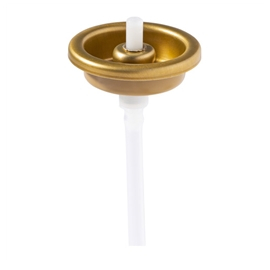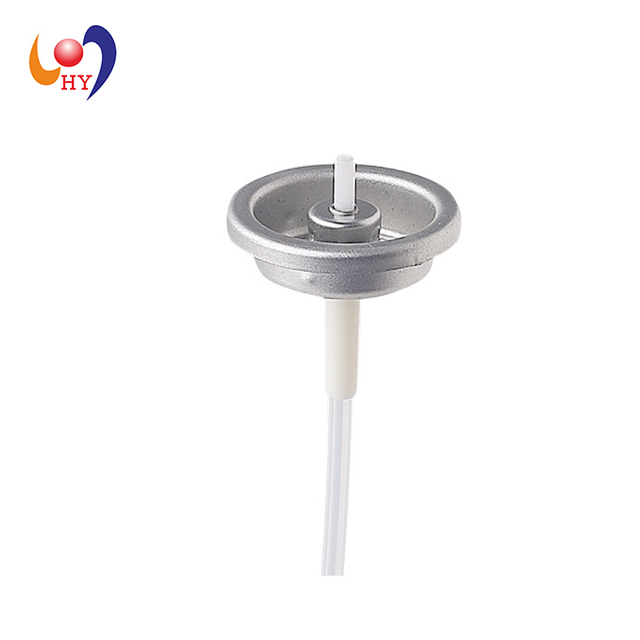- All
- Product Name
- Product Keyword
- Product Model
- Product Summary
- Product Description
- Multi Field Search


Views: 186 Author: Site Editor Publish Time: 2025-05-20 Origin: Site









An aerosol valve plays a pivotal role in ensuring the functionality, safety, and performance of aerosol-based products. Whether it's a spray paint, deodorant, pharmaceutical mist, or cooking oil spray, the valve determines how effectively and efficiently the product is dispensed. But despite its small size, selecting the correct aerosol valve is not as straightforward as it may seem. It involves a combination of technical compatibility, user expectations, formulation sensitivity, and container design. This article explores the different types of aerosol valves and provides a comprehensive guide on how to choose the most suitable one for your application.
An aerosol valve typically consists of several key components:
| Component | Function Description |
|---|---|
| Actuator | The user-interface part that is pressed to release the product |
| Stem | Channel through which the product flows from the container to the actuator |
| Housing | The main body of the valve that contains the internal pathways |
| Spring | Ensures the valve remains closed when not actuated |
| Gasket | Creates a seal to prevent leakage |
| Dip Tube | A tube that extends into the product to direct it toward the valve mechanism |
Each of these parts must be carefully selected and assembled to suit the product's characteristics. If one component is mismatched, it can lead to poor spray performance, leakage, or even container failure.
The formulation of your aerosol product is perhaps the most critical factor in valve selection. Thicker products like gels, foams, or emulsions require wider valve openings and special internal designs to handle viscosity. Conversely, thinner liquids such as air fresheners or perfumes can work effectively with standard metering valves.
Additionally, the chemical makeup of the formulation can interact with valve materials. For example, aggressive solvents may degrade plastic parts or corrode metal springs. In such cases, specialized materials like stainless steel or PTFE-coated components should be considered to maintain long-term integrity.
There are several dispensing mechanisms, and choosing the right one ensures optimal user experience:
Continuous Spray Valve – Ideal for deodorants, air fresheners, or hair sprays.
Metered Dose Valve – Used in pharmaceuticals or room sprays to dispense a precise quantity per actuation.
Foaming Valve – Essential for shaving foams, whipped toppings, or household cleaners.
Powder Valve – Designed for products with dry, fine particulates such as dry shampoos or body powders.
The intended use of your aerosol product directly affects which type of valve structure and actuator design will meet your needs.

Not all aerosol cans are created equal. Valves must be tailored to match the can’s neck size, internal pressure tolerance, and intended sealing method (crimp-on or snap-on). Common industry standard sizes for valves are 1-inch and 20mm, though custom specifications are sometimes required.
When considering compatibility, take into account:
Valve cup dimensions
Material compatibility (tinplate, aluminum, PET)
Crimping force requirements
Valve stem length and dip tube length
Mismatched components could lead to issues like leakage, misfiring, or regulatory non-compliance.
The choice of actuator is just as important as the valve mechanism itself. A poorly designed actuator can lead to finger fatigue, uneven spray patterns, or poor directional control. Consider the following:
Ergonomics: Should be easy to press with minimum force.
Spray pattern: Fine mist, narrow stream, broad fan, or direct jet.
Orientation usage: Some valves are designed for 360-degree or inverted use.
The actuator’s design also plays a branding role. Unique shapes, tactile feedback, and functional styling can enhance the perceived quality of the product and increase user satisfaction.
Compliance with international aerosol standards is non-negotiable. The valve must not only function reliably but also meet safety criteria set by organizations such as:
DOT (Department of Transportation)
UN (United Nations) for hazardous substances
FDA (Food and Drug Administration) for medical or food-grade products
REACH and RoHS for material safety and environmental compliance
Using unverified or substandard aerosol valves can expose brands to product recalls, legal action, or reputational harm. Always ensure the valve is tested for:
Pressure tolerance
Leakage resistance
Longevity and actuation cycles
Temperature stability

Answer: No. Different formulations require different valve specifications. Using a "one-size-fits-all" approach can result in functional failure.
Answer: Measure from the top of the container to just above the bottom, then subtract 1-2mm for clearance. Custom trimming may be needed during production.
Answer: Lead time varies depending on complexity and customization. For standard valves, 2–4 weeks is common, while custom designs may require 6–8 weeks.
Answer: Essential tests include spray pattern analysis, leakage tests, crimp inspection, compatibility with propellant, and actuation cycle testing.
Answer: Generally, aerosol valves are single-use and not intended for reuse. However, some components can be separated and recycled depending on material type.
To ensure you choose the most appropriate aerosol valve, use the following checklist:
| Factor | Recommendation |
|---|---|
| Product Type | Liquid, foam, gel, powder – match with corresponding valve structure |
| Container Size and Material | Ensure valve size and materials are compatible |
| Dispensing Requirements | Choose metered or continuous spray based on intended use |
| Environmental Exposure | Select corrosion-resistant materials for aggressive formulations |
| Compliance | Confirm valve meets regulatory and safety standards |
| Actuator Design | Match to user ergonomics and branding needs |
| Testing | Conduct full functional and pressure tests before final approval |
Copyright © 2024 HengYu Aerosol Can. All Rights Reserved. Sitemap | Supported by leadong.com 粤ICP备2024338468号